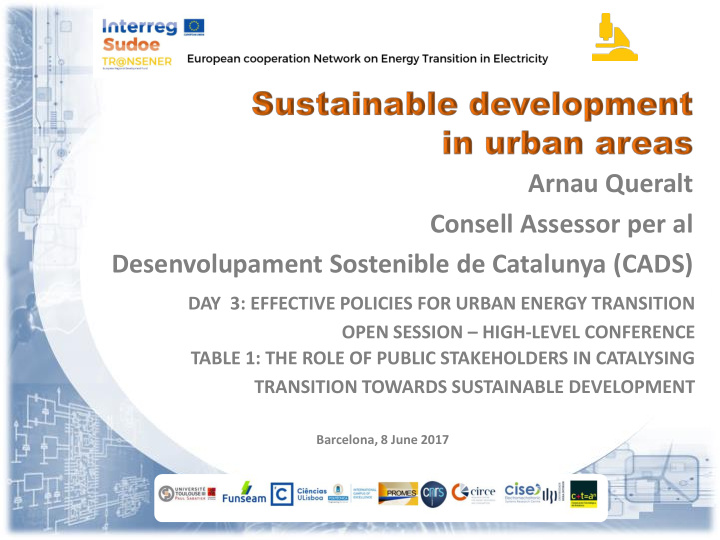



Arnau Queralt Consell Assessor per al Desenvolupament Sostenible de Catalunya (CADS) DAY 3: EFFECTIVE POLICIES FOR URBAN ENERGY TRANSITION OPEN SESSION – HIGH-LEVEL CONFERENCE TABLE 1: THE ROLE OF PUBLIC STAKEHOLDERS IN CATALYSING TRANSITION TOWARDS SUSTAINABLE DEVELOPMENT Barcelona, 8 June 2017
‒ Half of the world's population lives in urban areas, occupying 2.8% of the planet's land surface. ‒ According to United Nations projections, by 2050 the population of the world will reach 9 billion (as against 7 billion today) with urban populations accounting for 86% in developed countries and 64% in developing countries. ‒ 85% of the population increase by 2050 will be in urban areas (mainly in poor districts) in developing countries (Africa and Asia) with substantial growth on the edges of cities or in the urban-rural transition area, where urban and rural lifestyles overlap, sometimes leading to friction. ‒ This rapid urbanisation will be accompanied by the explosion of the mega-cities (those with more than 10 million inhabitants), their number rising from 2 in 1970 to 28 in 2014 and 41 by 2050. In all of them the existence of extensive slums will be an important issue. 2
‒ The urbanisation process will not be efficient: in the next 30 years in developing countries the urban population will double and the land area occupied will treble as a result of the increase in unplanned settlements. ‒ Cities generate 80% of world GDP, but urban life leads to very important changes in the consumption of resources and the use of energy. Cities are responsible for over half of greenhouse gas emissions. ‒ Between 2005 and 2015 over 1.5 billion people were affected by natural disasters, as a result of which 700,000 died, 1.4 million were injured and over 23 million lost their homes. ‒ Rapid, unplanned urbanisation, combined with poverty, inequality and climate change are factors which increase the risk of disasters. ‒ The effects of disasters are especially serious in developing countries, which accounted for 89% of all deaths with material losses equivalent to 5% of their GDP. 3
‒ Indoor and outdoor air pollution is the biggest environmental health risk: it is blamed for approx. 7 million premature deaths per year worldwide, most of them in cities. ‒ Around half of all cities with more than 100,000 inhabitants worldwide are located in water-scarce basins. Water scarcity can be expected to get much worse as a result of climate change and urban growth. ‒ Waste generation is increasing specially in developing countries and above all emerging economies cities. The production of waste could double worldwide by 2025. ‒ Many urban areas have no organized waste collection and disposal: about 70% of municipal waste ends up on landfill sites (with surface water, ground water or soils pollution + GHG emissions). 4
‒ 70% of the population of Europe is urban, a percentage which is expected to rise, especially in peri-urban areas, which are growing four times faster than urban areas. ‒ The global market and competition for resources, as well as the impact of global environmental phenomena (such as GHG emissions) on these resources, place Europe, and especially its cities, in a vulnerable position given that they lack the resources they need (fossil fuels, minerals and food, etc.). ‒ Air pollution is the main environmental risk for health in the EU-28: in the period 2011-2013 the population exposed to PM 10 levels higher than the limits set by the EU ranged from 17% to 30%, while 83% were exposed to concentrations exceeding the stricter WHO limit. ‒ The same applies to O 3 , with exposure rates ranging from 15% (EU limit) to 98% (WHO limits). 5
(SOME) KEY ELEMENTS FOR AN URBAN TRANSFORMATION ‒ Urban development within the limits of the planet (low-carbon cities, contributing to reduce global environmental change). ‒ Good environmental conditions (condition for urban quality of life). ‒ Cites connected with their hinterland (environmental goods and services, food, energy, material resources, etc.) ‒ Citizens at the core of the city (infrastructures and technology only a – very useful- tool). ‒ Socio-economic inclusive and participatory cities (socio-economic inequalities and exclusion threaten the quality of life and stability of urban societies. ‒ Smart cities … for smart citizens? ‒ Specific character of cities: no-single-development-model exists (based on social, economic and cultural trends and heritage). 6
MAKE CITIES AND HUMAN SETTLEMENTS INCLUSIVE, SAFE, RESILIENT AND SUSTAINABLE 11.1 By 2030, ensure access for all to adequate, safe and affordable housing and basic services, and upgrade slums. 11.2 By 2030, provide access to safe, affordable, accessible and sustainable transport systems for all, improving road safety, notably by expanding public transport, with special attention to the needs of those in vulnerable situations, women, children, persons with disabilities and older persons. 11.3. By 2030, enhance inclusive and sustainable urbanization and capacity for participatory, integrated and sustainable human settlement planning and management in all countries. 7
11.4. Strengthen efforts to protect and safeguard the world's cultural and natural heritage. 11.5. By 2030, significantly reduce the number of deaths and the number of people affected and substantially decrease the direct economic losses relative to global gross domestic product caused by disasters, including water – related disasters, with a focus on protecting the poor and people in vulnerable situations. 11.6. By 2030, reduce the adverse per capita environmental impact of cities, including by paying special attention to air quality and municipal and other waste management. 11.7 By 2030, provide universal access to safe, inclusive and accessible green and public spaces, in particular for women and children, older persons and persons with disabilities. 8
Thanks for your attention! Website: http://cads.gencat.cat Email: cads@gencat.cat Twitter: @catsostenible 9
Recommend
More recommend